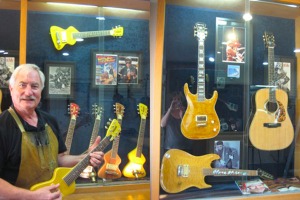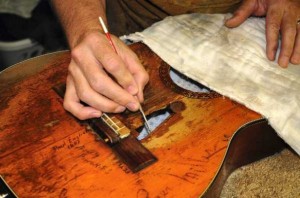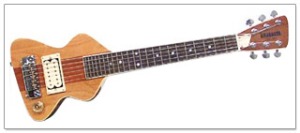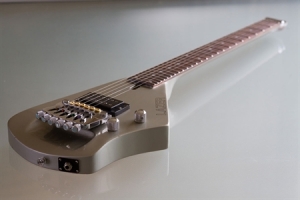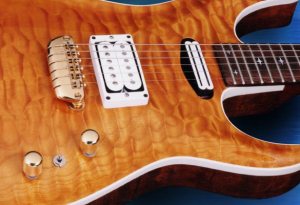If you grew up in the 1980s, chances are you instantly recognized the guitar pictured above. It is the so-ironically-small-it’s-cool humbucking monster Marty McFly plugs into an enormous amp at the start of Back To The Future.
Contrary to what you might think, this was not a stage prop built for comic relief or the director’s subtle commentary on the excesses of 80’s hair metal. The guitar is a real, mass-produced instrument called the Chiquita, and it’s still being made today in Austin, TX by luthier Mark Erlewine. If you’re like me, you’ll be interested to know that you can live out your fantasy of recreating the scene by ordering one through the Erlewine Guitars website for around $500 (Note: building a 10 ft. amp for authenticity will cost considerably more).
The Man Behind The Icon
After apprenticing with his cousin Dan up in Michigan in the late 1960s, Mark Erlewine partnered with him to start their own guitar company in Ann Arbor in 1969. In 1972 his cousin began working for Herb David’s guitar store, which led Mark to buy the company. He moved the shop to Austin in 1974, where he sat in as a pedal steel player after work in the bars.
For the next 43 years, the list of people for whom Mark would build and repair instruments reads like a who’s who of the Austin (and larger) music scene: Billy Gibbons (who actually helped design the Chiquita), Bob Dylan, Sting, Andy Summers, Mark Knopfler, Bruce Springsteen, Stevie Ray and Jimmy Vaughan, Eric Johnson, Albert King, Bo Diddley, Johnny Winter, Joe Walsh, Jimmy Buffet, John Fogerty, Paul McCartney, Billy Squier, Pat Metheny and of course, Willie Nelson. It is actually Mark’s miracle-working that has kept Willie’s signature Martin N-20 (named Trigger) held together since he first got it in 1969.
His Guitars
While much of the work Mark does is custom, he does produce two standard models: the Chiquita and the Lazer. You may have seen these pop up sometimes under the brand name Hondo (of the International Music Company). Mark leased the patent for both guitars to the Japanese manufacturer and distributor from 1980 until 1985. However, since they are both Erlewine’s designs, he is still able to produce them by hand out of his shop. These are the models you want as a collector, since the Hondo models were compromised with a mass-market production style. Given the Chiquita’s unique scale length, having a precision, well-built set up is especially important.
The Chiquita was originally designed in collaboration with Billy Gibbons in 1979 as a travel guitar. The marketing around it still touts it as “nearly a foot shorter than a Strat” and easy to take on planes. Only 28″ long and 4.5 lbs., it is made from a solid piece of Honduras maghogany. The fretboard is rosewood, with a 19″ scale length over 23 frets, which means you can’t just throw on .010s and use standard tuning. To get around this, you can tune up three half-steps so the top and bottom strings are a G, or you can use a heavier set of strings. Erlewine recommends .013, .017, .022, .036, .046, and .056. It has Schaller tuners at one end and a Schaller wrap-around bridge at the other. A single DiMarzio humbucker is connected a lone volume knob for an extremely simplified setup. New models can run $300-$500, with used ones often found for less.
The Lazer was designed solely by Mark Erlewine as a more ergonomic and lightweight full scale guitar with 24 frets. It uses a patented fine tuning system known as the Wine-O-Matic bridge and employs neck-through construction for greater sustain. Pickups come in an array of options. Johnny Winter is known for playing one. Buying one new direct from Erlewine costs around $600 depending on the specs.
The Erlewine Automatic is a highly customizable template Mark has developed, often using carved maple tops. Mark Knopfler used an Automatic for recording the intro to Dire Strait’s “Money For Nothing.”
While not ultra-rare, finding authentic Erlewine guitars on the market isn’t exactly commonplace. When dealing with a seller, be sure to ask about the dates of manufacture and determine whether it was mass-produced as a Hondo or hand-crafted by Mark. This affects the value and quality considerably. At the end of the day, the hand-made versions are well-built, unconventional guitars that will travel well and make a great conversation piece when you take it out of the case.

